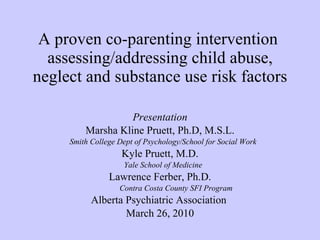Sfi Allsite Marsha Et Al. April 2010
•Als PPT, PDF herunterladen•
0 gefällt mir•299 views
This document summarizes a presentation on a co-parenting intervention for addressing child abuse, neglect, and substance use risk factors. The intervention focuses on strengthening family bonds and parental involvement to help buffer against risks like marital dissatisfaction that can increase substance use. A study using a tool called the Family Circles Instrument found that fathers' and mothers' relationships with their own fathers predicted their closeness with their children, and that closeness in the parental relationship further explained father-child closeness. Increasing the sample size and use of the standard tool could strengthen these findings.
Melden
Teilen
Melden
Teilen

Empfohlen
Weitere ähnliche Inhalte
Was ist angesagt?
Was ist angesagt? (19)
Communication Patterns Moderating the Relationship between Self

Communication Patterns Moderating the Relationship between Self
Men's versus Women's Self-Esteem: Influences of Childhood Trauma and Parental...

Men's versus Women's Self-Esteem: Influences of Childhood Trauma and Parental...
Substance abuse linked to genetic, environmental, and peer influences

Substance abuse linked to genetic, environmental, and peer influences
Andere mochten auch
Andere mochten auch (8)
Ähnlich wie Sfi Allsite Marsha Et Al. April 2010
Ähnlich wie Sfi Allsite Marsha Et Al. April 2010 (20)
Sibling relationships among offspring of depressed parents

Sibling relationships among offspring of depressed parents
Mothers with eating disorders, depression and anxietyArticolo diagnosi

Mothers with eating disorders, depression and anxietyArticolo diagnosi
ArticleEffect of a Paraprofessional Home-Visiting Interven.docx

ArticleEffect of a Paraprofessional Home-Visiting Interven.docx
Who Loves Ya Baby: Finding and Engaging Absent and Marginalized Fathers

Who Loves Ya Baby: Finding and Engaging Absent and Marginalized Fathers
Sfi Allsite Marsha Et Al. April 2010
- 1. A proven co-parenting intervention assessing/addressing child abuse, neglect and substance use risk factors Presentation Marsha Kline Pruett, Ph.D, M.S.L. Smith College Dept of Psychology/School for Social Work Kyle Pruett, M.D. Yale School of Medicine Lawrence Ferber, Ph.D. Contra Costa County SFI Program Alberta Psychiatric Association March 26, 2010
- 7. The Family Circles Instrument: Pictorial Representations of Father Involvement: Examples by a Mother Examples by a Father
- 9. Question 1a: Are there generational differences in father’s centrality between family-of-origin and current-nuclear family?
- 10. Question 1b: Are there generational differences in father-child closeness between family-of-origin and current-nuclear family?
- 11. Question 2a: Are there similar generational differences in mother’s centrality between family-of-origin and current-nuclear family?
- 12. Question 2b: Are there similar generational differences in mother-child closeness between family-of-origin and current-nuclear family?
- 13. Question 3: Do family-of-origin measures predict father involvement in the current nuclear family? NO – for predicting father’s centrality YES – for predicting father-child closeness
- 14. Question 3 (continued): Which family-of-origin measures predict father-child closeness in the current nuclear family? FATHERS MOTHERS Family-of-Origin Measure Father’s centrality in the family Father-child closeness r = .25, p <.09 r = .35, p<.06 Overall family structure Mother-father closeness r = .33* Mother’s centrality in the family r = .38* Mother-child closeness r = .35* # extended family members r = .41**
- 15. Question 4: Does mother’s relationship with the father or child explain additional variance in father-child closeness, beyond what is explained by family-of-origin experiences ? For fathers, closeness in the couple relationship explained additional variance in their closeness with their child. For mothers, closeness in their relationship with their child explained additional variance in father-child closeness.
- 16. According to Fathers: Proportion of Explained Variance in Father-Child Closeness
- 17. According to Mothers: Proportion of Explained Variance in Father-Child Closeness
- 18. Next Steps for Family Circles … Pictorial representations of family relationships shed new light on mothers’ and fathers’ perceptions of father involvement. To strengthen our findings, we need to increase our sample size (especially the number of Hispanic/Latino participants) and increase our use of the standard Family Circles form. WE NEED YOUR HELP TO DO THIS.
